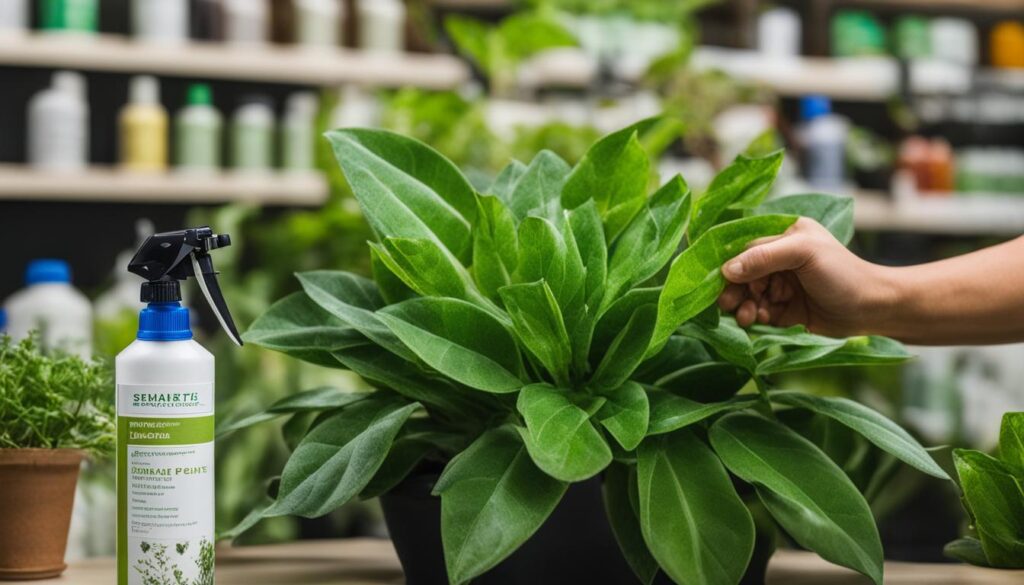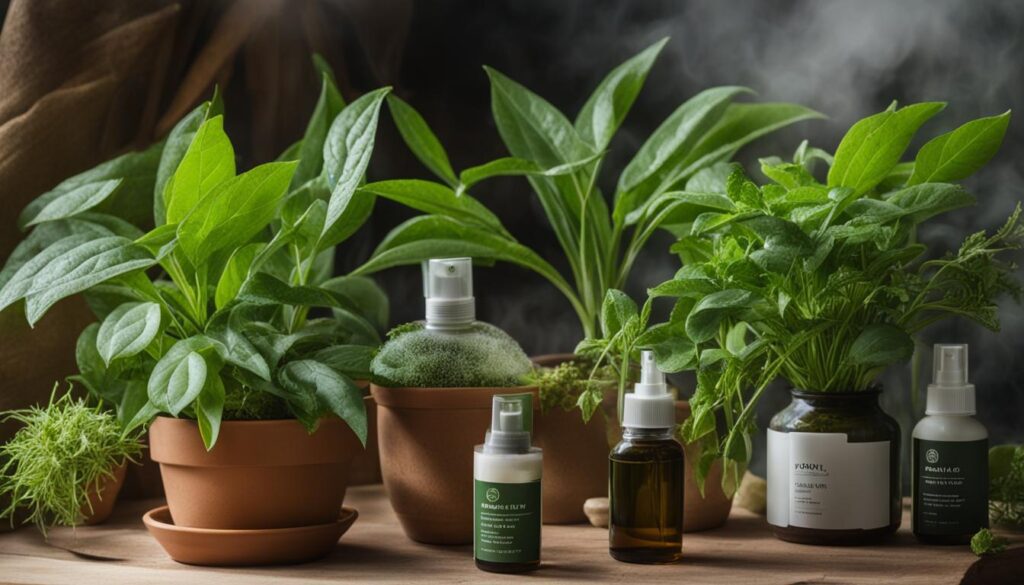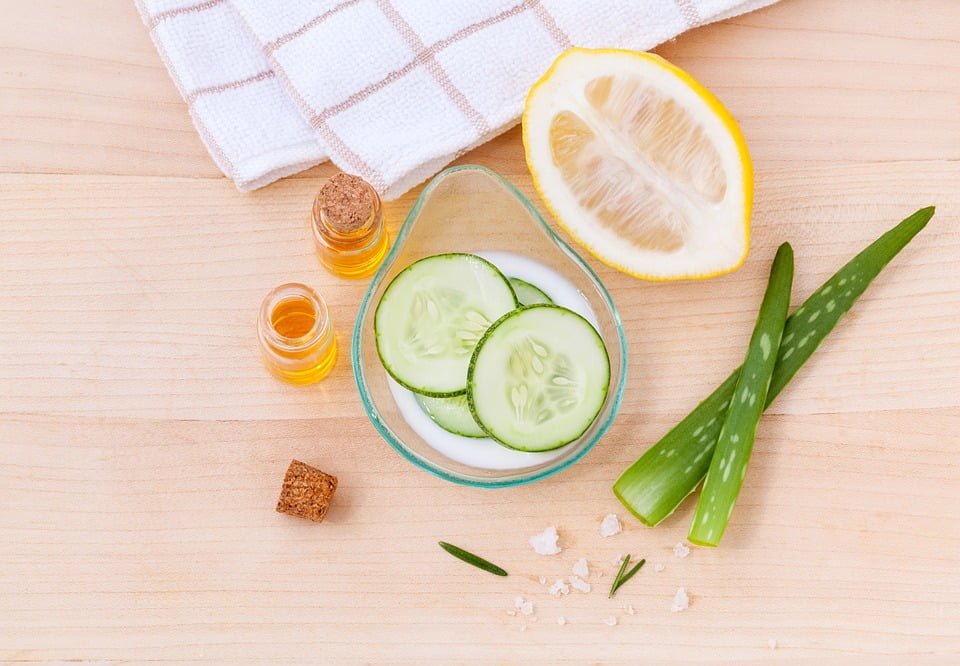Indoor plants are a popular addition to many households, but they can be vulnerable to pests. To keep your indoor plants healthy and pest-free, it’s essential to use pesticides correctly. This guide will provide you with valuable information on the use of safe pesticides for indoor plants, ensuring the well-being of your indoor flora.
Key Takeaways:
- Understanding the purpose and benefits of pesticides for indoor plants
- Types of pesticides available for controlling different pests
- The debate between organic and synthetic pesticides and their pros and cons
- Homemade pesticide options using natural ingredients
- Preventive measures to avoid pest infestations in indoor plants
Understanding Pesticides: What are Pesticides?
Pesticides are chemical substances designed to kill, prevent, or control pests in plants. They play a crucial role in protecting indoor plants from various pests that can damage their growth and overall health. The term “pesticide” is derived from the words “pest” and “cide,” meaning “to kill.” Pests can cause significant harm to plants, affecting their leaves, stems, flowers, and fruits. Throughout history, farmers have used pesticides to ensure the health and productivity of their crops.
When it comes to indoor plants, pesticides serve the purpose of eliminating or managing pest populations. These chemical agents are formulated to target specific pests, effectively eradicating them from your plants. By using pesticides correctly, you can safeguard your indoor plants and maintain their optimal condition.
“Pesticides are like superheroes for your indoor plants, protecting them from the destructive forces of pests.” – Dr. Greenthumb
Pesticides act by disrupting the biological processes of pests, inhibiting their growth, or directly killing them. They come in various forms, including sprays, powders, granules, and systemic treatments that are absorbed by the plants. Each type of pesticide has its own mode of action, allowing for targeted pest control. Some pesticides are broad-spectrum, meaning they can kill a wide range of pests, while others specifically target certain types of pests, such as insects, fungi, or rodents.
| Type of Pesticide | Purpose |
|---|---|
| Insecticides | To control and eliminate insects that may infest indoor plants, such as aphids, mealybugs, and spider mites. |
| Herbicides | To remove unwanted plants, like weeds, from indoor environments. |
| Fungicides | To prevent and treat fungal infections, such as mildew caused by high humidity. |
| Rodenticides | To control rodents, such as rats and mice, that may pose a threat to indoor plants. |
Understanding the different types of pesticides and their purpose is crucial in effectively managing pest problems in your indoor plants. By choosing the right pesticide and using it safely according to the manufacturer’s instructions, you can maintain a healthy environment for your indoor flora.
Types of Pesticides for Indoor Plants
When it comes to protecting your indoor plants from pests, there are various types of pesticides available. Each type of pesticide targets different pests and provides specific benefits for indoor plant care.
Insecticides for Indoor Plants
Insecticides are specifically designed to control and eliminate insects that may infest indoor plants. Common indoor plant pests such as aphids, mealybugs, and spider mites can be effectively managed with the use of insecticides. These pesticides disrupt the life cycle of pests and prevent further infestations. Some insecticides come in spray form, while others are available as granules or systemic treatments that are applied to the soil.
Herbicides for Indoor Plants
If your indoor plants are suffering from unwanted weeds, herbicides can help eliminate these intruders. Herbicides are designed to target and remove specific types of plants, including weeds, without harming your indoor plants. They are available in various forms, such as sprays, granules, or selective herbicides that only target specific weed species.
Fungicides for Indoor Plants
Fungal infections can be a common problem for indoor plants, especially in environments with high humidity. Fungicides are used to prevent and treat fungal infections such as mildew and mold. These pesticides come in different forms, including sprays, powders, or systemic treatments that are absorbed by the plant’s roots and transported throughout the plant. Fungicides work by disrupting the growth and reproduction of fungi.
Rodenticides for Indoor Plants
Rodents like rats and mice can pose a threat to indoor plants by damaging the roots, stems, and leaves. Rodenticides are specifically designed to control and eliminate these pests. These pesticides are available in different forms, such as bait stations, pellets, or blocks, and are effective in reducing rodent populations. It’s important to use rodenticides with caution and in accordance with safety guidelines due to their potential toxicity to other animals and humans.
Understanding the different types of pesticides available for indoor plants is essential for effectively managing and protecting your indoor flora. By choosing the right pesticide for the specific pest problem and following the manufacturer’s instructions, you can ensure the health and well-being of your indoor plants.
Organic vs. Synthetic Pesticides for Indoor Plants
When it comes to protecting your indoor plants from pests, you have a choice between using organic or synthetic pesticides. Both options have their pros and cons, and understanding these differences can help you make an informed decision.
Organic Pesticides for Indoor Plants
Organic pesticides are derived from natural sources and are generally considered safer for humans and the environment. They often contain ingredients like neem oil, pepper spray, and essential oils. These pesticides work by repelling or suffocating pests, disrupting their mating cycles, or interfering with their feeding habits.
- Pros of Organic Pesticides:
- Environmentally friendly
- Less harmful to beneficial insects and animals
- Reduced risk of chemical exposure for humans
- Cons of Organic Pesticides:
- May require more frequent applications
- May be less effective against certain pests
- Can have a strong odor
Synthetic Pesticides for Indoor Plants
Synthetic pesticides are chemically created to target specific pests and can be highly effective in controlling infestations. These pesticides often contain active ingredients that kill or disrupt the nervous systems of pests.
- Pros of Synthetic Pesticides:
- Highly effective in eliminating pests
- Longer residual activity
- Wide range of pest control options
- Cons of Synthetic Pesticides:
- Potential harm to beneficial insects and animals
- Increased risk of chemical exposure for humans
- Environmental impact
Choosing the Right Pesticide for Your Indoor Plants
The choice between organic and synthetic pesticides ultimately depends on factors such as the specific pest problem, personal preferences, and environmental considerations. If you have a minor pest issue and prioritize environmental safety, organic pesticides may be the better choice. However, if you’re dealing with a severe infestation and need immediate and effective results, synthetic pesticides may be a more suitable option.
It’s important to carefully read and follow the instructions on pesticide labels, regardless of whether you choose organic or synthetic options. Always use pesticides as directed, taking necessary safety precautions to protect yourself, your plants, and the environment.
Homemade Pesticides for Indoor Plants
When it comes to protecting indoor plants from pests, homemade pesticides offer a natural and safe alternative. These DIY remedies can effectively control common pests and help maintain the health and vitality of your indoor flora. Here are some popular homemade pesticide options:
Neem Oil Extract
Neem oil extract is a well-known and highly effective homemade pesticide for indoor plants. It can control pests like spider mites and whiteflies, which are common nuisances for houseplants. Neem oil works by suffocating the insects and disrupting their feeding and reproductive cycles. To use neem oil extract, dilute it with water according to the instructions on the packaging and spray it on the affected plants. Make sure to cover both the upper and lower surfaces of the leaves.
Pepper Spray
Pepper spray made from household peppers is another easy and effective homemade pesticide for indoor plants. The strong scent and taste of the peppers repel insects and deter them from infesting your plants. To make pepper spray, blend a few hot peppers with water and strain the liquid. Dilute the pepper solution with more water if needed and spray it on the plants. Be sure to test the spray on a small area of the plant first to ensure it doesn’t cause any damage.
Soap and Water Pesticide
A simple soap and water mixture can also be used as an effective pesticide for indoor plants. The soap suffocates soft-bodied insects like mites, beetles, and aphids. To make the soap and water pesticide, mix a few drops of mild liquid soap with water in a spray bottle. Spray the solution on the affected plants, targeting the pests directly. Avoid using soaps that contain additives like fragrances or moisturizers, as they may harm the plants.
Essential Oil Spray
Essential oils, such as basil and lavender, can be mixed with water to create a natural pesticide for indoor plants. These oils have insect-repelling properties and can help control pests like aphids and spider mites. Dilute a few drops of the essential oil of your choice in water and spray it onto the plants. Keep in mind that some essential oils may cause allergic reactions in certain individuals or pets, so use them with caution.
Garlic Oil Spray
Garlic oil spray is a potent homemade pesticide that can help repel insects like aphids. To make the spray, crush a few garlic cloves and soak them in mineral oil overnight. Strain the mixture and mix the garlic-infused oil with water. Spray the solution on the affected plants, focusing on the areas where pests are present. Garlic oil spray is best used as a preventive measure or for minor infestations.
“Homemade pesticides can offer a safe and effective solution for protecting your indoor plants from pests. However, it’s important to use these remedies responsibly and in appropriate concentrations. Always test the homemade pesticide on a small area of the plant first to ensure it doesn’t cause any harm. Additionally, be mindful of the specific pests you’re targeting and adjust your homemade pesticide accordingly. With the right approach, you can keep your indoor plants healthy and pest-free using natural and homemade remedies.”
How to Prevent Pests in Indoor Plants
Prevention is key to maintaining healthy indoor plants and avoiding pesky pest infestations. By taking a proactive approach and implementing a few simple strategies, you can create an environment that discourages pests from taking up residence in your indoor plants.
Regular Plant Checks
Regularly inspecting your indoor plants is an essential practice to catch any signs of pests early on. Look for insects, webs, chewed leaves, or any other unusual signs of damage. If you spot any pests, take immediate action to prevent them from spreading to other plants.
Optimizing Environmental Conditions
Creating the right environmental conditions for your indoor plants can help deter pests. Ensure your plants are receiving the proper amount of light, as some pests thrive in low-light conditions. Additionally, maintain the appropriate temperature and humidity levels for your plants, as certain pests are more likely to infest plants in specific environmental conditions.
Proper Watering
Watering your indoor plants properly is essential for plant health and can help prevent pest problems. Overwatering can create conditions that attract pests, such as fungus gnats, while underwatering can weaken plants, making them more susceptible to infestations. Make sure to water your plants according to their specific needs and avoid leaving excess water sitting in the saucers.
Implementing Natural Pest Deterrents
Using natural pest deterrents can help prevent infestations in your indoor plants. Various plants, such as marigolds, lavender, and rosemary, have natural pest-repellent properties. Placing these plants near your indoor plants can help keep pests at bay. You can also create homemade pest sprays using ingredients like garlic, neem oil, or peppermint to deter pests from your plants.
By regularly checking your plants, optimizing environmental conditions, and practicing proper watering techniques, you can create a less favorable environment for pests and reduce the risk of infestations. Implementing natural pest deterrents can also provide an extra layer of protection for your indoor plants. Remember, prevention is always better than dealing with a full-blown pest problem!
Tips for Using Natural and DIY Insecticides
When it comes to protecting your indoor plants from pests, natural and DIY insecticides can be a safe and effective solution. Here are some tips to help you use these alternatives to traditional pesticides:
- Washing Plants: Regularly washing the leaves of your indoor plants with a damp cloth or spraying them with water can help remove pests and keep them at bay.
- Physical Removal of Pests: For larger pests like earwigs, caterpillars, and slugs, manually removing them by hand can be an effective method of control. Take care to dispose of them properly to prevent further infestations.
- Pruning Infested Parts: If you notice that certain parts of your plants are heavily infested with pests, consider pruning those areas to prevent the problem from spreading to other parts of the plant.
By implementing these nonchemical pest control methods, you can protect your indoor plants without resorting to synthetic pesticides that may have potential risks and side effects.
“Using natural and DIY insecticides can be a safe and effective solution for protecting your indoor plants from pests.”
Table: Comparison Between Natural and Synthetic Insecticides
| Insecticide Type | Natural Insecticides | Synthetic Insecticides |
|---|---|---|
| Composition | Mainly derived from natural sources such as plant extracts, essential oils, and homemade mixtures. | Chemically created to specifically target pests. |
| Effectiveness | May require more frequent applications, but can be effective in controlling pests. | Generally more potent and may provide longer-lasting control. |
| Environmental Impact | Considered safer for the environment and beneficial insects, with less risk of contaminating soil and water sources. | Potential risks to non-target organisms and environmental contamination if not used properly. |
| Health Risks | Less likely to cause harm to humans, pets, and beneficial insects when used as directed. | Potential risks to human health and wildlife if exposed or ingested. |
It’s crucial to remember that natural and homemade insecticides may require more frequent application compared to synthetic options. However, by following the tips mentioned above and considering the comparison table, you can ensure the safe and effective use of natural pest control methods for your indoor plants.
– Can Pesticides Used for Indoor Plants also Promote Lush Growth?
When using indoor plant spraying techniques, it’s important to consider the potential effects of pesticides on plant growth. While some pesticides may promote lush growth, others can have detrimental effects. It’s crucial to carefully research and select pesticides that will benefit your indoor plants without harming them.
Conclusion
Safely using pesticides for indoor plants is crucial to maintain the health and vitality of your indoor flora. By understanding the different types of pesticides, weighing the pros and cons of organic versus synthetic options, and utilizing homemade pesticides, you can ensure safe pesticide use.
Regularly checking your plants for signs of pests and creating optimal environmental conditions will help prevent infestations. Additionally, proper watering practices are essential to deter pest attraction. By following these preventive measures, you can effectively keep pests at bay.
Remember, the well-being of your indoor plants is dependent on safe pesticide use. By implementing natural and DIY insecticides when necessary, you can protect your plants without compromising your health, the well-being of your loved ones, or the environment.
FAQ
What is the purpose of pesticides for indoor plants?
Pesticides are used to kill, prevent, or control pests in indoor plants. They protect plants from damage caused by insects, weeds, fungi, and rodents.
What are the different types of pesticides for indoor plants?
There are insecticides to control insects, herbicides to remove unwanted plants, fungicides to prevent fungal infections, and rodenticides to control rodents.
Are organic or synthetic pesticides better for indoor plants?
Organic pesticides are derived from natural sources and are considered safer for humans and the environment. Synthetic pesticides are chemically created but may be more effective. The choice depends on the specific pest problem and personal preferences.
Can I make my own pesticides for indoor plants?
Yes, homemade pesticides using ingredients like neem oil, pepper spray, soap and water mixtures, essential oils, and garlic oil can be effective and safer alternatives to chemical pesticides.
How can I prevent pests in my indoor plants?
Regularly checking your plants for signs of pests, optimizing environmental conditions, proper watering, and practicing good plant hygiene can help prevent pest infestations.
What are some tips for using natural and DIY insecticides?
You can wash plant leaves, physically remove pests, prune infested parts, and use proper dilution and application techniques for homemade insecticides.
How do I safely use pesticides for indoor plants?
Safely using pesticides involves understanding the different types, following instructions carefully, and ensuring you protect yourself, your family, and the environment. Dilution and application techniques should be followed for homemade solutions as well.











